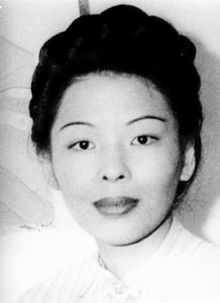Dai Ailian
| Dai Ailian (戴爱莲) | |
|---|---|
 | |
| Born |
May 10, 1916 Trinidad |
| Died |
February 9, 2006 (aged 89) Beijing |
| Nationality | Chinese |
| Occupation | Dancer, dance teacher, choreographer, company director |
| Spouse(s) | Ye Qianyu |
Dai Ailian (Chinese: 戴爱莲; Wade–Giles: Tai Ai-lien; May 10, 1916 – February 9, 2006) was a Chinese dancer and an important figure in the modern history of dance in China. She was born in 1916 into an overseas Chinese family living in Trinidad.[1] Her years as a dance teacher and educator helped China build a generation of dancers, choreographers, and educators. She is known in China as the "Mother of Chinese Modern Dance".[2]
Early life
Dai Ailian was born in Trinidad to a 3rd generation Chinese family, whose origins were in Xinhui, Guangdong Province. Influenced by her mother, who loved music, even when she was very small she liked to dance. She began studing ballet in Trinidad from the age of 7.
In 1931 at the age of 14, Dai Ailian was one of 12 students accepted into the Masters class at the Jooss School of Ballet and so went to England to continue he studies. She went on to study modern dance at Jooss Modern Dance School where she learned the theory and techniques developed by Rudolf von Laban. She also worked in the studios of Anton Dolin and Margaret Craske.[1] In this period, She choreographed a number of works, including a solo performance called Yang Guifei in 1936 based on her interpretation of the historical character.
Founding of modern Chinese dance
In 1937, Dai took part in benefit performances organized by the China Campaign Committee in London to raise funds for the Hong Kong-based China Defense League, headed by Soong Ching Ling, wife of Sun Yat-sen. After reading Red Star Over China by Edgar Snow during the Japanese invasion of China, she travelled to Hong Kong with the help of Soong in 1940. She travelled to China to study the folk dances and operas and created pieces based on folk traditions such as The Drum of the Yao People. Dai choreographed, performed, and taught dance all over China. She was named principal of the Beijing Dancing School when it was first set up in 1954.[3]
After the founding of the People's Republic of China in 1949, Dai Ailian's artistic path broadened. In the early 1950s, she was involved in the creation and leading performance of the first ballet in China: Dove of Peace. She also created two dances with strong national flavor, Dance of Lotus Flowers (based on a Shaanxi folk dance) and Flying Apsaras (inspired by the Dunhuang murals), which were acclaimed both at home and abroad and won the gold prize at the World Youth Festival. By the 1990s, authoritative dance organizations designated these two dances as 20th century classics of Chinese dance. From 1950, Dai Ailian began to work at various leading posts, such as the director of the Central Song and Dance Ensemble, the first dean of the Beijing Academy of Dance, the director and adviser of the Central Ballet Troupe, and vice-chairman of the Chinese Dancers' Association.
Her trademark works include Lotus, Flying Apsaras, Longing for Home, The Mute Carries the Cripple, Tibetan Spring, Anhui Folk Dance, and For Sale. All of them are fruits of her studies of Chinese dances. Although classical and some folk dances were restricted in China during the Cultural Revolution (1966–1976), Dai remained influential in Chinese and international dance circles after China opened up to the world and began its economic reform process in the 1980s. She introduced a number of noted dancers such as Rudolf Nureyev and Margot Fonteyn to teach in China and tried her best to promote Chinese dancers to the world.
Dai also participated in many international activities beginning in the 1980s, including working as a judge at international dance competitions, leading Chinese dance delegations to international dance competitions, and attending international academic meetings on dance. In 1982, she was elected the vice-chairman of the International Council for Dance of UNESCO, the United Nations' cultural and educational organ, and attended the meeting of the council in Paris every year till her death on February 9, 2006.
Personal life

Dai met her first husband, the painter Ye Qianyu, shortly after arriving in Hong Kong in 1940. They married soon after in Chongqing, however they divorced in 1950, and she later remarried.
Dai led a single life after divorcing her second husband in 1967. When a China Daily reporter asked if she felt lonely sometimes in 1982, her answer was: "Life is interesting with its ups and downs. I am always occupied, so I have no time to feel lonely." In devoting most of her 90 years to her love of dance and her roots, she will be most remembered not only for her soul-stirring performances, but also for paving the way for Chinese ballerinas.
References
- ↑ 1.0 1.1 Lily Xiao Hong Lee, A. D. Stefanowska, Sue Wiles, ed. (2002). Biographical dictionary of Chinese women: The Twentieth Century, 1912-2000. M E Sharpe Inc. p. 118. ISBN 978-0765607980.
- ↑ "Chinese Modern Dance". Cultural China.
- ↑ "Dai Ailian, a Legendary Ballerina". China.org.cn. Retrieved 2012-02-03.